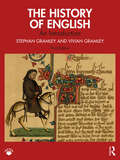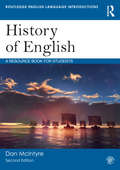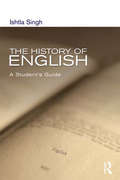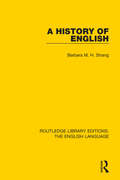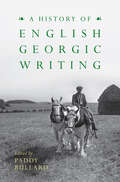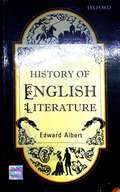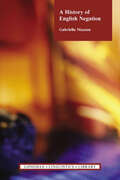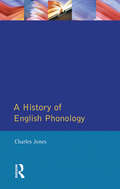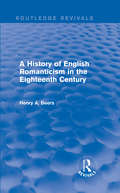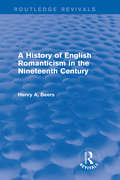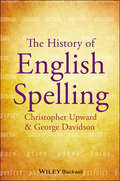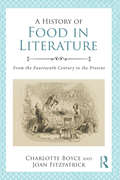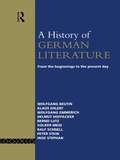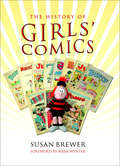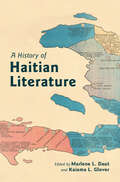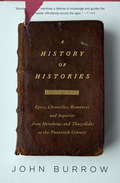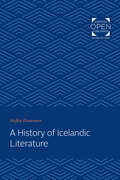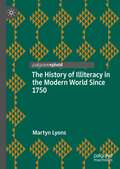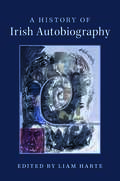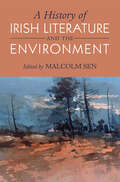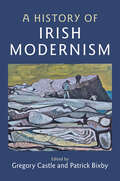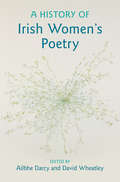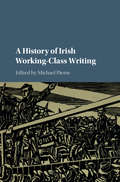- Table View
- List View
The History of English: An Introduction
by Stephan Gramley Vivian GramleyThe History of English: An Introduction provides a chronological analysis of the linguistic, social, and cultural development of the English language from before its establishment in Britain around the year 450 to the present. Each chapter represents a new stage in the evolution of the language, all illustrated with a rich and diverse selection of primary texts. The book also explores the wider global course of the language, including a historical review of English in its pidgin and creole varieties and as a native and/or second language in the Caribbean, Africa, Asia, and Australasia.The third edition, carefully revised and updated throughout, includes:● chapter introductions and conclusions to assist in orientation plus additional marginal references throughout;● the addition of 21 timelines often running from Old English to Present-Day English and focusing on a variety of features;● a new focus on the relevance of change for and in Present-Day English;● discussions on the role and image of women, the (in-)visibility of social classes, and regional variation in English;● material on bilingualism, code-switching, and borrowing, and on the effects of the social media on language use;● over 90 textual examples demonstrating linguistic change and over 100 figures, tables, and maps, including 31 colour images, to support and illuminate the text;● updated online support material including brief introductions to Old and to Middle English, further articles on linguistic, historical, and cultural phenomena which go beyond the scope of the book, additional sample texts, exercises, and audio clips.With study questions as well as recommendations for further reading and topics for further study, The History of English is essential reading for any student of the English language and will be of relevance to any course addressing the origins and development of the English language.
History of English: A Resource Book for Students (Routledge English Language Introductions)
by Dan McIntyreRoutledge English Language Introductions cover core areas of language study and are one-stop resources for students. Assuming no prior knowledge, books in the series offer an accessible overview of the subject, with activities, study questions, sample analyses, commentaries and key readings – all in the same volume. The innovative and flexible ‘two-dimensional’ structure is built around four sections – introduction, development, exploration and extension – which offer self-contained stages for study. Each topic can also be read across these sections, enabling the reader to build gradually on the knowledge gained. This revised second edition of History of English includes: ❑ a comprehensive introduction to the history of English covering the origins of English, the change from Old to Middle English, and the influence of other languages on English; ❑ increased coverage of key issues, such as the standardisation of English; ❑ a wider range of activities, plus answers to exercises; ❑ new readings of well-known authors such as Manfred Krug, Colette Moore, Merja Stenroos and David Crystal; ❑ a timeline of important external events in the history of English. Structured to reflect the chronological development of the English language, History of English describes and explains the changes in the language over a span of 1,500 years, covering all aspects from phonology and grammar, to register and discourse. In doing so, it incorporates examples from a wide variety of texts and provides an interactive and structured textbook that will be essential reading for all students of English language and linguistics.
The History of English: A Student's Guide
by Ishtla SinghThe History of English provides an accessible introduction to the changes that English has undergone from its Indo-European beginnings to the present day. The text looks at the major periods in the history of English, and provides for each a socio-historical context, an overview of the relevant major linguistic changes, and also focuses on an area of current research interest, either in sociolinguistics or in literary studies. Exercises and activities that allow the reader to get 'hands-on' with different stages of the language, as well as with the concepts of language change, are also included. By explaining language change with close reference to literary and other textual examples and emphasising the integral link between a language and its society, this text is especially useful for students of literature as well as linguistics.
A History of English (Routledge Library Editions: The English Language #26)
by Barbara M. StrangA History of English, first published in 1970, is a book for beginners in linguistic history. This title examines the changes in English language speech and writing over a period of almost 2000 years, whilst also exploring more recent changes within the author’s living memory. This title aims to raise countless issues for enquiry and discussion, and its purpose is to serve as a springboard for language history learning rather than a textbook.
A History of English Autobiography
by Adam SmythA History of English Autobiography explores the genealogy of autobiographical writing in England from the medieval period to the digital era. Beginning with an extensive introduction that charts important theoretical contributions to the field, this History includes wide-ranging essays that illuminate the legacy of English autobiography. Organized thematically, these essays survey the multilayered writings of such diverse authors as Chaucer, Bunyan, Carlyle, Newman, Wilde and Woolf. Written by a host of leading scholars, this History is the definitive, single-volume collection on English autobiography and will serve as an invaluable reference for specialists and students alike.
A History of English Georgic Writing
by Paddy BullardThe interconnected themes of land and labour were a common recourse for English literary writers between the sixteenth and twentieth centuries, and in the twenty-first they have become pressing again in the work of nature writers, environmentalists, poets, novelists and dramatists. Written by a team of sixteen subject specialists, this volume surveys the literature of rural working lives and landscapes written in English between 1500 and the present day, offering a range of scholarly perspectives on the georgic tradition, with insights from literary criticism, historical scholarship, classics, post-colonial studies, rural studies and ecocriticism. Providing an overview of the current scholarship in georgic literature and criticism, this collection argues that the work of people and animals in farming communities, and the land as it is understood through that work, has provided writers in English with one of their most complex and enduring themes.
History Of English Literature
by Edward AlbertThe fifth edition of Edward Albert’s History of English Literature, first published in 1979, offers its readers a detailed view of how English literature has evolved through the centuries. Starting from the Old English period to the literature of mid-twentieth century, the book takes a look at how English literature has developed across each period. It talks about the major literary genres of each age, like poetry, prose and drama, their major proponents and offers an extensive list of the notable works published during that period. Special focus has been given to Chaucer, Shakespeare, Milton, Pope and Dryden, whose writings strongly influenced the literary output of their time. Each chapter also contains quotes, together with translations wherever needed, from the many works cited in the text. The book also comes with a broad list of writings under ‘Suggestions for Further Reading’ to guide readers who want to further explore the subject.
A History of English Negation (Longman Linguistics Library)
by Gabriella MazzonNegation is one of the main functions in human communication.A History of English Negation is the first book to analyse English negation over the whole of its documented history, using a wide database and accessible terminology. After an introductory chapter, the book analyses evidence from the whole sample of Old English documents available, and from several Middle English and Renaissance documents, showing that the range of forms used at any single stage is wider, and the pace of their change considerably faster, than previously commonly assumed. The book moves on to review current formalised accounts of the situation in Modern English, tracing the changes in rules for expressing negation that have intervened since the earliest documented history of the language. Since the standard is only one variety of a language, it also surveys the means of negation used in some non-standard and dialectal varieties of English. The book concludes with a look at relatively recently born languages such as Pidgins and Creoles, to investigate the degree of naturalness of the principles that rule the expression of English negation.
A History of English Phonology (Longman Linguistics Library)
by Charles JonesThis is an attempt to view historical phonological change as an ongoing, recurrent process. The author sees like events occurring at all periods, a phenomenon which he considers is disguised by too great a reliance upon certain characteristics of the scholarly tradition. Thus he argues that those innovations arrived at by speakers of the English language many years ago are not in principle unlike those that can be seen to be happening today. Phonological mutations are, on the whole, not to be regarded as unique, novel, once only events. Speakers appear to present to speech sound materials, a limited set of evaluative and decoding perceptions, together with what would seem to be a finite number of innovation producing stratagems in response to their interpretation. It is stressed that this interpretation may itself be a direct product of the kinds of data selected for presentation in traditional handbooks and Jones notes the fact that phonological change is often "messy" and responsive to a highly tuned ability to perceive fine phonetic detail of a type which, by definition, rarely has the opportunity to surface in historical data sources.
A History of English Romanticism in the Eighteenth Century (Routledge Revivals)
by Henry A. BeersFirst published in 1926, this title presents the great artistic and literary innovations of the Romantic movement according to an often overlooked and unacknowledged definition of ‘Romanticism’, which is of particular relevance in the consideration of the English Romantic spirit: pertaining to the style of the Christian and popular literature of the Middle Ages.
A History of English Romanticism in the Nineteenth Century (Routledge Revivals)
by Henry A. BeersA History of English Romanticism in the Nineteenth Century, first published in 1926, presents the great artistic and literary innovations of the Romantic movement according to an often overlooked and unacknowledged definition of ‘Romanticism’, which is of particular relevance in the consideration of the English Romantic spirit: pertaining to the style of the Christian and popular literature of the Middle Ages. The author recapitulates the key contributions of English poets – including Scott, Coleridge and Keats - in light of their recovery of certain themes and leitmotifs that clearly distinguish the Romantic style. In addition, the development of the Romantic movement in France and Germany is given some attention, and the specific tendencies of their respective approaches is considered in relation to England. The emergence of the Pre-Raphaelites is investigated, and a tentative evaluation of the progress of English Romanticism in the nineteenth century is offered.
The History of English Spelling (The Language Library #26)
by Christopher Upward George DavidsonThe History of English Spelling reveals the history of Modern English spelling, tracing its origins and development from Old English up to the present day. Includes a wealth of information and data on English spelling not available anywhere else Features a complementary website with additional material at www.historyofenglishspelling.info Includes detailed coverage of the contributions from French, Latin, Greek - and the many other languages - to our current orthography Serves as a companion volume to Geoffrey Hughes's A History of English Words in the same series
A History of Food in Literature: From the Fourteenth Century to the Present
by Charlotte Boyce Joan FitzpatrickWhen novels, plays and poems refer to food, they are often doing much more than we might think. Recent critical thinking suggests that depictions of food in literary works can help to explain the complex relationship between the body, subjectivity and social structures. A History of Food in Literature provides a clear and comprehensive overview of significant episodes of food and its consumption in major canonical literary works from the medieval period to the twenty-first century. This volume contextualises these works with reference to pertinent historical and cultural materials such as cookery books, diaries and guides to good health, in order to engage with the critical debate on food and literature and how ideas of food have developed over the centuries. Organised chronologically and examining certain key writers from every period, including Chaucer, Shakespeare, Austen and Dickens, this book's enlightening critical analysis makes it relevant for anyone interested in the study of food and literature.
A History of German Literature: From the Beginnings to the Present Day
by Wolfgang Beutin Klaus Ehlert Wolfgang Emmerich Helmut Hoffacker Bernd Lutz Volker Meid Ralf Schnell Peter Stein Inge StephanSince the appearance of its first edition in Germany in 1979, A History of German Literature has established itself as a classic work used by students and anyone interested in German literature. The volume chronologically traces the development of German literature from the Middle Ages to the present day. Throughout this chronology, literary developments are set in a social and political context. This includes a final chapter, written for this latest edition, on the consequences of the reunification of Germany in 1990. Thoroughly interdiscipinary in method, the work also reflects recent developments in literary criticism and history. Highly readable and stimulating, A History of German Literature succeeds in making the literature of the past as immediate and engaging as the works of the present. It is both a scholary study and an invaluable reference work for students.
The History of Girls' Comics
by Susan BrewerSusan Brewer taps into the nostalgic women s market for comics from their childhood Jackie, Girl's Own, Bunty etc, from the early days in Victorian England to teen mags and TV-related comics, including Teletubbies and CBeebies. The book also covers partworks such as the highly collectable Vicky and other collectables, including annuals, covermounts and giveaways and toys and games tie-ins, including board games.
A History of Haitian Literature
by Marlene L. Daut Kaiama L. GloverFrom nineteenth-century antislavery pamphleteering to accounts of ecological catastrophe in twenty-first-century fiction, Haitian literature has resounded across the globe since the nation's revolutionaries declared independence in 1804. Starting with pre-revolutionary writing, including the emergence of Haitian Creole letters, extending to the long, largely francophone nineteenth century, and concluding with present-day Haitian writing in the English language, A History of Haitian Literature presents the political, cultural, and historical frameworks necessary to comprehend Haiti's vast literary output. Whether writing in Haiti or its wide-ranging diasporas, Haitian authors have boldly contributed to pressing conversations in global letters while reflecting Haiti's unique cultural and historical experiences. Considering an expansive array of poets, playwrights, and novelists – such as Baron de Vastey, Juste Chanlatte, Demesvar Delorme, Edwidge Danticat, René Depestre, Kettly Mars, Dany Laferrière, and Évelyne Trouillot – the contributors to this volume offer a fresh examination of a richly polyglot, transnational literary tradition that spans more than two centuries.
A History of Histories: Epics, Chronicles, and Inquiries from Herodotus and Thucydides to the Twentieth Century
by J. W. BurrowTreating the practice of history not as an isolated pursuit but as an aspect of human society and an essential part of the culture of the West, John Burrow magnificently brings to life and explains the distinctive qualities found in the work of historians from the ancient Egyptians and Greeks to the present. With a light step and graceful narrative, he gathers together over 2,500 years of the moments and decisions that have helped create Western identity. This unique approach is an incredible lens with which to view the past. Standing alone in its ambition, scale and fascination, Burrow's history of history is certain to stand the test of time.
A History of Icelandic Literature
by Stefán EinarssonOriginally published in 1957. Stefán Einarsson covers almost a thousand years of Icelandic literature in tracing the influence of the sagas and eddic poems. The book begins with background on Icelandic literature, outlining its literary roots in Scandinavia. Following this, Einarsson provides a thorough survey of Icelandic literature through the 1950s.
The History of Illiteracy in the Modern World Since 1750
by Martyn LyonsThis Palgrave Pivot examines the history of literacy with illiterate and semi-literate people in mind, and questions the clear division between literacy and illiteracy which has often been assumed by social and economic historians. Instead, it turns the spotlight on all those in-between, the millions who had some literacy skills, but for whom reading and writing posed difficulties. Its main focus is on those we have often labelled ‘illiterates’, rather than those who enjoyed full competence in reading and writing in modern society. In offering a historical perspective on the ‘problem’ of illiteracy in the modern world, it also questions some enduring myths surrounding the phenomenon. This book therefore has a revisionist objective: it intends to challenge conventional wisdom about illiteracy.
A History of Indian Poetry in English
by Rosinka ChaudhuriA History of Indian Poetry in English explores the genealogy of Anglophone verse in India from its nineteenth-century origins to the present day. Beginning with an extensive introduction that charts important theoretical contributions to the field, this History includes extensive essays that illuminate the legacy of English in Indian poetry. Organized thematically, these essays survey the multilayered verse of such diverse poets as Henry Louis Vivian Derozio, Rabindranath Tagore, Nissim Ezekiel, Dom Moraes, Kamala Das, and Melanie Silgardo. Written by a host of leading scholars, this History also devotes special attention to the lasting significance of imperialism and diaspora in Indian poetry. This book is of pivotal importance to the development of Indian poetry in English and will serve as an invaluable reference for specialists and students alike.
A History of Irish Autobiography
by Liam HarteA History of Irish Autobiography is the first ever critical survey of autobiographical self-representation in Ireland from its recoverable beginnings to the twenty-first century. The book draws on a wealth of original scholarship by leading experts to provide an authoritative examination of autobiographical writing in the English and Irish languages. Beginning with a comprehensive overview of autobiography theory and criticism in Ireland, the History guides the reader through seventeen centuries of Irish achievement in autobiography, a category that incorporates diverse literary forms, from religious tracts and travelogues to letters, diaries, and online journals. This ambitious book is rich in insight. Chapters are structured around key subgenres, themes, texts, and practitioners, each featuring a guide to recommended further reading. The volume's extensive coverage is complemented by a detailed chronology of Irish autobiography from the fifth century to the contemporary era, the first of its kind to be published. Contains twenty-five chapters by leading scholars from around the world, providing an authoritative critical survey of different types of Irish autobiography, notable subgenres, common themes, and important texts and writers; Includes the first detailed chronology of Irish autobiography from the arrival of Christianity in the fifth century to the contemporary era; Each chapter features a guide to recommended further reading, enabling readers to build upon the concepts provided in each chapter.
A History of Irish Literature and the Environment
by Malcolm SenFrom Gaelic annals and medieval poetry to contemporary Irish literature, A History of Irish Literature and the Environment examines the connections between the Irish environment and Irish literary culture. Themes such as Ireland's island ecology, the ecological history of colonial-era plantation and deforestation, the Great Famine, cultural attitudes towards animals and towards the land, the postcolonial politics of food and energy generation, and the Covid-19 pandemic - this book shows how these factors determine not only a history of the Irish environment but also provide fresh perspectives from which to understand and analyze Irish literature. An international team of contributors provides a comprehensive analysis of Irish literature to show how the literary has always been deeply engaged with environmental questions in Ireland, a crucial new perspective in an age of climate crisis. A History of Irish Literature and the Environment reveals the socio-cultural, racial, and gendered aspects embedded in questions of the Irish environment.
A History of Irish Modernism
by Gregory Castle Patrick BixbyA History of Irish Modernism examines a wide variety of artworks (from the 1890s to the 1970s), including examples from literature, film, painting, music, radio, and architecture. Each chapter considers a particular aspect of Irish culture and reflects on its contribution to modernism at large. In addition to new research on Irish Revival and cultural nationalism, which places them squarely in the modernist arena, chapters offer transnational and transdisciplinary perspectives that place Irish cultural production in new contexts. At the same time, the historical standpoint adopted in each chapter enables our contributors to examine how modernist practices developed across geographical and temporal distances. A History of Irish Modernism thus attests to the unique development of modernism in Ireland—driven by political as well as artistic concerns—even as it embodies aesthetic principles that are the hallmark of modernism in Europe, the Americas and beyond.
A History of Irish Women's Poetry
by Ailbhe Darcy David WheatleyA History of Irish Women's Poetry is a ground-breaking and comprehensive account of Irish women's poetry from earliest times to the present day. It reads Irish women's poetry through many prisms – mythology, gender, history, the nation – and most importantly, close readings of the poetry itself. It covers major figures, such as Máire Mhac an tSaoi, Eavan Boland, Eiléan Ní Chuilleanáin, as well as neglected figures from the past. Writing in both English and Irish is considered, and close attention paid to the many different contexts in which Irish women's poetry has been produced and received, from the anonymous work of the early modern period, through the bardic age, the coterie poets of Anglo-Ireland, the nationalist balladeers of Young Ireland, the Irish Literary Revival, and the advent of modernity. As capacious as it is diverse, this book is an essential contribution to scholarship in the field.
A History of Irish Working-Class Writing
by Michael PierseA History of Irish Working-Class Writing provides a wide-ranging and authoritative chronicle of the writing of Irish working-class experience. Ground-breaking in scholarship and comprehensive in scope, it is a major intervention in Irish Studies scholarship, charting representations of Irish working-class life from eighteenth-century rhymes and songs to the novels, plays and poetry of working-class experience in contemporary Ireland. There are few narrative accounts of Irish radicalism, and even fewer that engage 'history from below'. This book provides original insights in these relatively untilled fields. Exploring workers' experiences in various literary forms, from early to late capitalism, the twenty-two chapters make this book an authoritative and substantial contribution to Irish studies and English literary studies generally.
